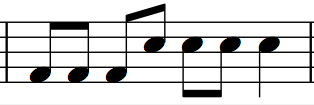Seven is an easy bucket drumming piece that is suitable for students in 3rd grade and up. The piece is written for two parts and is called Seven because the main motive comprises seven notes. The two parts sometimes interlock, contrast, or play together.
Seven can be played by any number of players and may be taught by notation or by rote. Score and Parts can be downloaded below, as well as a lesson plan and a Cheat Sheet in case you wish to make your own arrangement. Here is a video of a basic arrangement (don't be fooled by my serious expression, it's a really fun piece!):
Seven can be played by any number of players and may be taught by notation or by rote. Score and Parts can be downloaded below, as well as a lesson plan and a Cheat Sheet in case you wish to make your own arrangement. Here is a video of a basic arrangement (don't be fooled by my serious expression, it's a really fun piece!):
How to Teach it:
Whether teaching by notation or rote, I have students do a lot of movement and chanting/counting out loud before they begin to play the bucket.
I typically start by teaching the two transitions with students counting "1 2 3 4" or "1 2 3 4 5 6 7" out loud as they play. This is an easy way to start and gets the group playing together in unison before they have to play separate parts.
Transition 1 (Letter D) is most successful when students move their bodies to the beat.
Transition 2 (Letter F) involves dynamics, so it's convenient to talk about how to play at a musical dynamic by using appropriate stick heights, as bucket drumming can get loud if you're not careful.
Whether teaching by notation or rote, I have students do a lot of movement and chanting/counting out loud before they begin to play the bucket.
I typically start by teaching the two transitions with students counting "1 2 3 4" or "1 2 3 4 5 6 7" out loud as they play. This is an easy way to start and gets the group playing together in unison before they have to play separate parts.
Transition 1 (Letter D) is most successful when students move their bodies to the beat.
Transition 2 (Letter F) involves dynamics, so it's convenient to talk about how to play at a musical dynamic by using appropriate stick heights, as bucket drumming can get loud if you're not careful.
 Main Groove Combined
Main Groove Combined After teaching the transitions, your next goal is to get the students to play the main groove first on body percussion and then with sticks.
On the score, the main groove is found at Letter C and on the Cheat Sheet it is Bucket Part 1 and Bucket Part 2. If students first learn a composite part that contains all the pats and claps and then learn their individual part, things tend to go smoother. (See the measure labeled: Body Percussion - Combined).
Then play Body Percussion Part 1 and Body Percussion Part 2 together. Transfer that experience to sticks and buckets and the hardest part of the teaching is done. The claps become stick clicks and the pats are either bucket center or rim depending on the part.
Then all there is left to teach is the slow groove at G, the flashy but simple stick clicking at H, and the roll at the end. Put it all in order and the piece is done.
On the score, the main groove is found at Letter C and on the Cheat Sheet it is Bucket Part 1 and Bucket Part 2. If students first learn a composite part that contains all the pats and claps and then learn their individual part, things tend to go smoother. (See the measure labeled: Body Percussion - Combined).
Then play Body Percussion Part 1 and Body Percussion Part 2 together. Transfer that experience to sticks and buckets and the hardest part of the teaching is done. The claps become stick clicks and the pats are either bucket center or rim depending on the part.
Then all there is left to teach is the slow groove at G, the flashy but simple stick clicking at H, and the roll at the end. Put it all in order and the piece is done.

